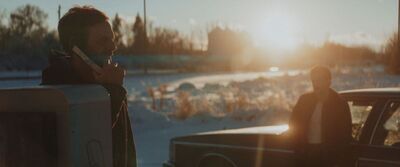
Set in 1992 in the northernmost United States, where criminals run drugs and guns over the border with Canada, “Blood for Dust” is a hard, nasty crime thriller about hard, nasty men. Directed by Rod Blackhurst from a script by David Ebeltoft, it tells you what kind of movie it is from its gruesome opening image and continues in that mode for another hour and forty-five minutes. It’s anchored to a lead performance by Scoot McNairy that ranks with the best of classic neo-noir.
McNairy plays a traveling defibrillator salesman named Cliff. He and his wife Amy (Nora Zehetner) are Christians who attend church regularly and have a child with cancer, and there’s nothing about Cliff that suggests he isn’t sincere about loving his family and seeking solace in prayer and the word of God. But he’s also the kind of guy who celebrates a big sale on the road by going to a strip joint. As the story unreels, we learn a lot of other things that complicate our image of Cliff. Somehow none of them make him seem like a hypocrite, just somebody who’s contradictory, and whose in-the-moment decisions are powered by impulses we don’t understand and that he’s not going to explain to anyone, certainly not the viewer.
Cliff has a friend named Ricky (Kit Harington of “Game of Thrones”), a self-styled bad boy with a smirky face, a whooping laugh, an infectious self-confidence, and some of the least flattering facial hair you’ve ever seen. Ricky knows Cliff is struggling and offers him a chance to make a lot of money all at once by serving as sort of a mule, driving guns into Canada, trading them for drugs and driving back (or the reverse). Ricky tells his contact on the American side of the border, a gangster named John (Josh Lucas, who nailing the character’s reptilian swagger), that his buddy Cliff is perfect for that kind of work because he looks and acts like a milquetoast-normal guy who couldn’t hurt a fly even if he wanted to. John agrees, assigning Cliff a mission and teaming him with a henchman and “minder” named Slim (Ethan Suplee—another of the excellent character actors gathered in this cast, which also features Stephen Dorff, who played a Ricky-like character in the 1996 crime flick “City of Industry“).
Things get darker and more disturbing from there. It’s best not to delve into the particulars, other than to say that there isn’t anything new here in terms of crime-movie situations, violent or otherwise (Ricky is very much a chaos-stirring “live wire” type, familiar from “Mean Streets,” “State of Grace,” “Menace to Society” and countless other crime flicks), and that the movie is less interesting when people are shooting each other than when they’re getting mad enough to consider drawing their guns in the first place; but also that, whatever its shortcomings, including too much solemnity and not enough jokes, there’s no denying that the film creates a powerful mood and sustains it.
Cliff is a struggling salesman archetype, with all the burdens and secret corruption you’d expect from that kind of character. So, in a strange way, is Ricky, though he’s more of a cowboy. If these actors were cast in a revival of “Glengarry Glen Ross,” McNairy would be Shelly “The Machine” Levine,” who justifies his shabby hard-selling of worthless real estate on grounds that he has a very sick daughter in the hospital, and Harrington would be Ricky Roma, the hotshot who brags about the big fish he’s landed and holds forth on how bourgeois morality is for suckers.
In the end, though, Cliff is the darker character because he does still have self-awareness, guilt, and the ghostly afterimage of a code. His criminality is borne of despair, and that film noir hero’s belief that the system is rigged against the little guy and it’s better to lash out and risk destroying yourself (and others) than let the days go by (water flowing underground). Cliff and Ricky also have that film noir hero aspect of being deluded and self-justifying. They’re both less sinned-against than sinning, but you wouldn’t know if from hearing them rationalize their actions.
The entire cast operates at a peak level of craft, but McNairy’s subtle, reactive performance helps elevate them all. The movie is good, but he’s great. The former costar of “Halt and Catch Fire” brings a grubby, desperate “Everyman” quality to a character who is no better than the animals he gets involved with, just housebroken. It’s not easy to give a blank-slate sort of performance without making the character seem undernourished or sketchy. This actor rises to the occasion. It’s a living Rorschach blot of an acting job. Every five minutes you see something different.
Technically, the film is impeccable. Blackhurst and his collaborators (including cinematographer Justin Derry, whose wide-frame compositions have a 1970s Gordon Willis vibe; editor Justin Oakley; and a brilliant sound team) have captured the dread and isolation that people on the fringes feel when they believe there’s no hope. I never really thought of the early ’90s as having a distinctive period flavor, but they did, and “Blood for Dust” captures it, right down to the mullets, the squarish TVs and computer monitors, and the red-orange glow cast by incandescent lights. Somehow this movie smells like cigarettes. It also has a steely menace—the real-world kind that hovers around the edges of a run-down gas station or abandoned house or patch of snowy woods way out in the country, where horrible things could happen and no one would know until a steam shovel unearthed a skull.
#movie #movies
